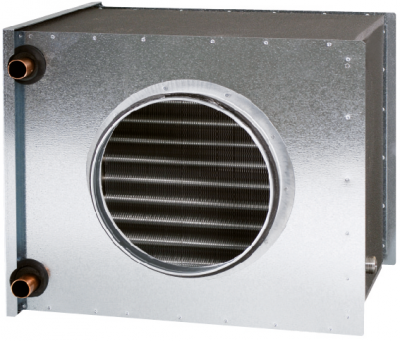Function
A cooler for ducts, or duct cooler, is used in an air transport system to cool air. The energy transfer takes place by means of cold water.
Material quality and thicknesses
For normal comfort ventilation, ducted chillers are manufactured from the following materials:
- Casing: Sendzimir galvanised steel or Alu-zinc sheet material;
- Cooling element:
- Pipes: copper
- Slats: aluminium;
- Condensation drip pan: stainless steel.
Coolers should be provided with a drip catcher and a drip tray, with a provision for condensation drainage with an intermediate siphon and with sufficient height to compensate for the pressure difference that occurs. The discharge pipe must also be provided with a pressure-free discharge.
Other choice of material, depending on the application, in consultation with the supplier.
Connections
The duct cooler is available with circular and rectangular connections.
Dimensions
The available nominal sizes of the intermediate coolers are standardized according to NEN-EN 1505 (rectangular connections) and NEN-EN 1506 (circular connections) and can be chosen as indicated in the tables for standard sizes, as mentioned in this guide in chapter 2.1.1.6 (rectangular connections) and 2.1.3.6 (circular connections). They refer to the internal dimensions with a tolerance of +0 to -5 mm. The dimensions depend on the manufacture.
Inspection possibilities
It must always be possible to inspect intermediate duct coolers for leaks and contamination. For this purpose, the cooler must be equipped with a removable inspection cover. This cover is attached to the housing in an airtight manner. It provides access to both sides of the battery, as well as to the condensation drip pan.
Assembly instructions
Duct coolers must be installed in accordance with the manufacturer's instructions. If present and at least meet the requirements according to section 3.1.4.
The duct cooler can only be used in horizontal air flows because of the condensation discharge. To this end, the cooler is equipped with a stainless steel condensation drip pan. The following must be taken into account:
a minimum distance from or to a bend, fan, valve, etc. For rectangular coolers, a minimum distance of 1 x the diagonal duct dimension is recommended. For circular chillers, a minimum distance of 2 x the connection diameter is recommended.
Sustainability aspects
Built-in coolers with circular connections can be connected to the air ducts more efficiently than coolers with rectangular connections and contribute to the airtightness of the air duct system, if these fittings have sufficient airtightness in accordance with NEN-EN 15727.


